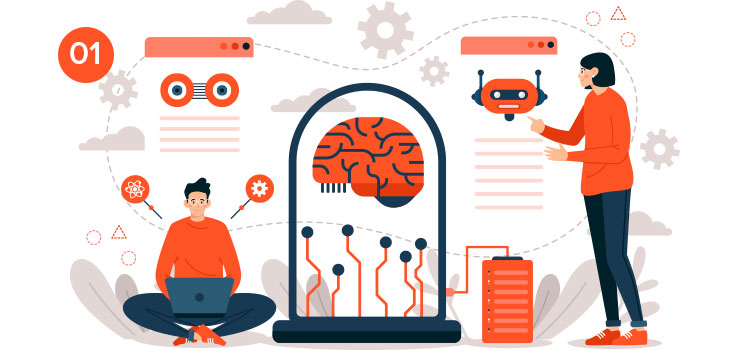Artificial Intelligence (AI) is one of the most rapidly expanding and popular, disruptive technologies currently in use all across the globe. AI is a component of Intelligent Process Automation (IPA) which also harnesses Robotic Process Automation (RPA). IPA solutions that enable hyperautomation are being widely adopted across several industries. AI is a crucial component thanks to its ability to automate the processing of huge volumes of unstructured content. This unstructured content is a challenge for nearly 90% of businesses and it continues to increase in volume at 50-60% per year.
Thanks to this ability, AI can easily boost operational efficiency and scalability of processes. In addition, AI has numerous other advantages – it empowers companies to deliver better customer experiences and streamline processes using intelligent automation. When harnessed for suitable use cases, AI and IPA can provide a substantial ROI. Moreover, 44% of organizations have reported operational cost savings as a result of AI implementations.
If you haven’t considered intelligent automation for your business, it may be time to explore use cases in your organization. The majority of businesses have ongoing investments in AI. Moreover, according to Gartner 65% of organizations will introduce IPA that leverages both AI and RPA by 2022.
Global spending on AI is expected to cross $55 billion this year alone with 80% plus businesses across the U.S. embracing this disruptive technology trend in order to sustain a competitive advantage. We are in the midst of a paradigm shift that will transform business operations and the story of AI and IPA in modern enterprises is still unfolding.
Here’s a closer look at some of the technological trends evolving in AI that have scope for automating a wider range of processes in various business operations.
1. Conversational Interactions
Initially, with the introduction of chatbots and other AI-based assistants, it was relatively easy to distinguish when one was interacting with a bot as opposed to a person. 2021 however may be the year we officially blur the lines between a bot and human support. Advancements in Natural Language Processing (NLP) along with ever-growing datasets for learning have begun to overcome the limitations of previous generations of chatbots.
Deep learning and semi-supervised models of ML have generated algorithms capable of creating responses structured along common speech patterns giving them a more human semblance. There has also been side-by-side learning into the non-ambiguous interpretation of input on the AI solution’s part in order to generate the most appropriate responses.
As things stand today, we generally prefer to have a human resolve queries or assist us in any manner possible. But with AI delivering relevant responses much faster, predicting future FAQs, and prompting more accurate answers we may choose to switch over to AI-generated answers. Such solutions are cost-effective, easily scalable, and increase customer delight and retention.
2. AI Working on the Edge
Most of the time when we are in contact with AI it is typically through the cloud. For instance, Google searches and Netflix recommendations all come through back-end AI processing that functions out of remote locations. AI algorithms have become capable of working on low-power devices happening on the “edge” near where data is collated and used.
This tech trend will continue in an upward trajectory throughout 2021 rendering AI-driven insights available despite the lack of rapid fiber optics and mobile networks. Made to measure processors that are constructed to conduct real-time analytics on the go are predicted to become an integral component of the technology we use on a daily basis.
3. AI-Fortified Cyber Security
Any progress in the age of digital innovation will call for enhanced digital security. There are a number of online threats that range from social engineering attacks to hacking and account phishing. Many of these threats are AI-augmented themselves, so it goes without saying that a defense system also founded in AI is the only countermeasure that is truly up to the task.
How can AI do this you ask? The answer lies in predictive analysis. AI can be used to flag suspicious activity and action pathways that are typically indicative of the foul play. The sooner AI can detect threats to security the faster it can intervene thereby increasing the chances of apprehending any form of cyber-attack.
It is expected that companies will continue to delegate increasingly larger portions of their budget towards digital reinforcement, especially since the advent of 5G and its super-fast wireless counterparts are all geared to provide new and innovative services again subject to cyber threats of their own.
4. The Question of Facial Recognition
AI-based facial recognition is a tech trend that is quickly gaining traction. You’ve seen mobile phones that can unlock with facial recognition. However, this tech trend is becoming popular with law enforcement bodies who are attempting to use it as a means of apprehending criminals and keeping crime in general at bay. The flip side of this situation is a compromise in privacy and the fact that we cannot assign a face to AI.
Countries like China are exploring ways to make facial scanning compulsory in order to avail of public transportation facilities and other communal amenities. While few take steps to make facial recognition a mandate, there are others such as San Francisco who have ruled in the opposite direction imposing a ban on the usage of facial recognition technology by metropolitan authorities.
Discussions on the matter of public surrender of privacy in exchange for security are likely to be a hot topic this year with not only technological experts weighing in but also leaders in fields such as anthropology and sociology.
5. Growing Role in Entertainment
AI involvement in the entertainment industry is still in its nascent stages with skeptics still debating if it will ever be fully accepted by the masses or not. AI’s current ability to create music, poetry, and art is still relatively limited. The results have been subject to criticisms such as – is it really art if it’s not human-made? However, it is being put to good use with potent results de-aging actors in many high-profile movies and shows, when a younger version of the actor is necessitated by the role.
Other entertainment avenues like social media are expected to follow suit. Instagram currently has a number of AI-generated influencers and brand ambassadors like Miquela whose Instagram handle lilmiquela is platform certified with 3 million followers. Music might not be AI’s strength just yet but platforms like Spotify have surpassed competitors in their ability to curate smart playlists based on user activity.
In part 2 of this blog series, we’ll explore more trends that are evolving from AI. Aside from AI trends, you could also take a look at the Why Hyperautomation is Imperative for Modern Enterprises.
In case you’re wondering how to go about implementing AI for your business, check out Pointers for Success on Your First AI Project.
If you’d like to explore opportunities where your business can benefit from AI solutions or IPA implementations for hyperautomation, the Rapid Acceleration Partners team would be glad to help. Our next-gen, AI-powered content intelligence platform RAPFlow enables full lifecycle AI orchestration on a single platform. When used in tandem with our RPA tool RAPBot, it provides end-to-end workflow automation capabilities that can be deployed in just weeks. You can even build your own use case and the platform can easily integrate with your existing systems. Book a demo to get a more detailed understanding of how our products can transform your business.




